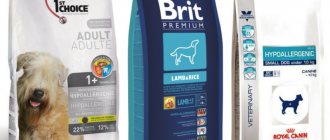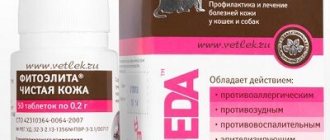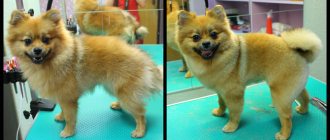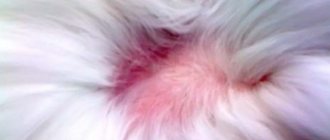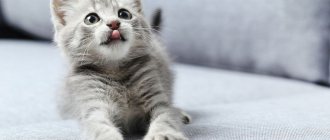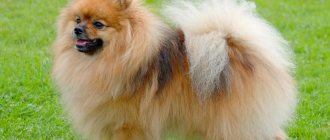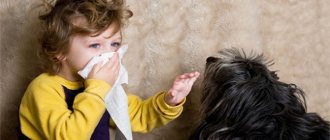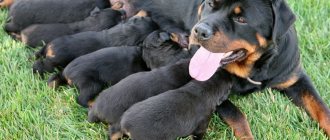Causes of bald spots in dogs on the back, paws, sides, tail, elbows, face
The most common groups of factors for the sudden formation of bald spots in dogs, veterinary specialists include hormonal disorders and non-hormonal causes. The first group includes:
- Hyperestrogenism. Hormonal imbalance is associated with increased production of female sex hormones. At the same time, owners should be aware that the risk of the disease is high not only in females, but also in males, estrogens can be produced. Hormone imbalance leads to hair loss in the external genital area. As the pathology develops, baldness spreads to the entire body of the animal.
- Not only excess, but also lack of estrogen can cause the formation of bald spots. This phenomenon is typical for sterilized individuals. At the same time, females experience hair thinning, a slowdown in growth rate, and then hair loss.
- Cushing's syndrome. For one reason or another, the dog’s pituitary gland begins to synthesize cortisol in large quantities. A hormonal disorder in the form of hyperadrenocorticism negatively affects the pet’s nervous system, leading to disruption of the kidneys and heart. A sick animal experiences polydipsia, increased urination, sagging abdomen, and weight gain.
Baldness most often affects the pet's torso. As a rule, hair does not fall out on the head and limbs. A similar pathogenesis is observed in dogs with long-term use of cortisol drugs for medicinal purposes.
- Growth hormone imbalance. The pathology is typical for males of such breeds as boxers, poodles, chow chows, and Pomeranians. During puberty, for a number of reasons, a disruption in the synthesis of growth hormone occurs, which is accompanied not only by a decrease in weight gain, underdevelopment of the skeletal and muscle structure, but also by symmetrical foci of baldness in the animal.
- In the pathogenesis of the formation of bald spots in dogs, diseases of the thyroid gland, characterized by hormonal imbalance, play an important role. Low levels of thyroxine synthesis, along with symptoms such as susceptibility to infections, lethargy, and obesity, lead to brittle hair and hair loss in dogs.
Hormonal causes of alopecia are usually accompanied not only by external manifestations in the form of unsatisfactory condition of the coat, but are also characterized by a number of symptoms. The animal loses or gains weight for no reason, its behavior changes, problems with the functioning of the heart, kidneys and other systemic disorders appear.
Due to the variety of causes of alopecia in dogs, there is no single method for treating this scourge in veterinary practice. The nature of therapeutic measures is determined by the root cause of the pathology.
If bald spots are discovered on a four-legged friend, the owner should not self-medicate; he must seek qualified help. A veterinary specialist will conduct a number of necessary clinical, laboratory, and instrumental examination methods in order to establish the root cause of the pathology and prescribe effective treatment.
So, if problems with the endocrine glands have led to the loss of fur in a dog, then the veterinarian makes efforts to reduce the negative effect of hormones on the animal’s body. Based on a special biochemical blood test for the level of biologically active substances, the animal can be prescribed therapeutic doses of hormonal drugs.
We suggest you familiarize yourself with: What is the name of the breed of cats similar to the Georgian. All cat breeds with photos
In case of alopecia caused by external parasites, first of all, the coat is treated with special shampoos to destroy adult fleas and lice-eaters. In case of development of sarcoptic mange or demodicosis, the dog is prescribed anti-acaricidal drugs, for example, Ivermectin, Dectomax and others.
Treatment of fur against fleas
Bald spots caused by pyoderma are treated with a course of antibacterial drugs. In case of a fungal infection, the animal is prescribed ointments or tablets with an antimycotic effect.
If hair loss is caused by vitamin deficiencies or a deficiency of minerals in foods, a veterinarian will correct the diet and recommend multivitamin and mineral supplements to food.
Regardless of the cause of baldness in a four-legged pet, the veterinarian will certainly include immunostimulating drugs in the treatment regimen. Immunomodulators and vitamins strengthen the body's resistance and make the animal's immune system more resistant to aggressive environmental influences.
On the recommendation of a veterinarian, the animal’s diet is enriched with brewer’s yeast, multivitamins, such as Biorhythm, Unitabs Brevers Complex with Q10.
Allergic reactions
The immune system protects the dog's body from foreign proteins. Immunocompetent cells compare their own and proteins received from outside. If an intruder is detected, a violent inflammatory reaction occurs that destroys the enemy.
The body of an allergy sufferer mistakes some relatively harmless compounds for harmful ones. Dermatitis occurs, accompanied by itching (pruritis), hair loss. Dogs react violently to food, certain foods, household chemicals, shampoos, pollen, and nematode toxins.
The dog's hair is falling out
Parameters of the smooth-haired dachshund
The dog's body is elongated and squat, its legs are short and powerful, which is convenient for movement, the muscular system is well developed, the dog is nimble, agile and flexible, ready to crawl through even a narrow hole. The dachshund's head is elongated with an elongated muzzle, which is not pointed. Smooth jaws with 42 teeth have a strong grip.
The eyes are clear, round and have a friendly look. The ears are of medium length, the tips reaching the cheekbone. The belly is tucked, and the body is graceful and each part of it flows smoothly into another, for example, the neck to the body. The limbs make up one third of the dog's height at the withers. The coat of the smooth-haired dachshund is very coarse and the hairs are densely packed. These parameters represent the general appearance and type of constitution of the smooth-haired dachshund.
Mr. Tail recommends: treatment and prevention of alopecia
The problems described above are only a small part of the diseases that cause hair loss. There are 5 main causes of hair loss:
- Allergies.
- Incorrect feeding.
- Hormonal imbalance.
- Parasitic infections.
- Stress.
Treatment for each specific case is considered separately. Self-diagnosis and therapy are strictly prohibited. Animals, like humans, have unique body characteristics that affect appearance, character and illness. Treatment for alopecia begins after tests and a detailed study of the dog’s medical record.
In addition, the doctor pays attention to food, places to walk and other features that owners often forget about.
Nevertheless, it is within the owner’s power to protect the pet from potential dangers. Preventive measures can and should be taken. There are 6 components of success that guarantee a dog a calm, healthy life:
- Regular treatment against parasites using properly prescribed products. They are different and are selected depending on the age, characteristics of the body and the character of the pet.
- Disinfection of food containers, sleeping places, clothes. They do this not only after infection, but constantly. Dishes are washed after every meal, bedding is washed once a week, clothes are washed after returning from a walk (especially if you were in the forest or walked in tall grass).
- Nutritional monitoring accompanied by medical consultations. Each dog is different and may not tolerate certain diets, so food selection and food substitutions are always risky.
- Taking care of your animal's immune system is important and requires a responsible approach. The pet needs a clear regime: food, walks, games. Dogs require attention and time no less than children.
- Vaccination cannot be ignored; it provides protection and builds immunity to many deadly diseases.
- Proper completion of the walk will help eliminate various diseases. It is necessary to comb the animal, check the fur for ticks and dirt. Wash your paws.
It is important to monitor the condition of the dog during the molting period, and look after the coat during pregnancy and feeding. During the season, you need to scratch your dog twice a day, this allows the coat to renew itself faster and eliminates the occurrence of dandruff, as well as digestive difficulties due to clogged intestines.
Why does hair fall out in clumps?
Veterinary specialists include the following among the group of non-hormonal causes of baldness in four-legged friends:
- Seasonal shedding. The phenomenon is physiological in nature and is observed in spring and autumn. When keeping pets in a warm apartment, many owners can observe year-round molting. Illiterate coat care, too infrequent brushing, and the use of non-specialized detergents are often factors that provoke hair loss.
- Allergy. Recently, veterinary specialists have increasingly noted the development of allergic reactions in furry patients to food components, household detergents, and medications. Food and household allergies in dogs often manifest themselves in the form of skin itching and focal baldness.
- Dachshund owners may encounter a cause of alopecia called acanthosis nigricans. The disease is caused by improper functioning of the sebaceous glands and is characterized by hair loss in the armpits and the appearance of an unpleasant odor from the pet’s skin.
We suggest you read: Eye diseases in hamsters - I love hamsters
Acanthosis nigricans
- External parasites - fleas, lice eaters, ticks - are a common reason for animals losing their attractive appearance. Veterinary specialists often diagnose diseases such as demodicosis and sarcoptic mange, the causative agents of which are intradermal parasites. Contact with a sick animal, low immunity, genetic predisposition of some breeds (Shar Pei, bull terriers) are a common cause of tick infection and severe baldness in dogs.
- The non-hormonal cause of alopecia in animals is various bacteriological skin diseases, for example, pyoderma. Purulent inflammation of the upper layers of the epidermis affects the hair follicles, which leads to hair loss.
- The cause of bald spots in dogs is not only bacteria, but also fungi. Most often, the owner encounters such an insidious disease of fungal etiology as ringworm. Foci of alopecia become covered with a crust. The animal is itching. The disease is dangerous for children and the elderly.
- In a breed such as the Doberman, veterinarians often detect the so-called Blue Doberman syndrome. The pathology consists of mutational bald spots followed by the formation of multiple pustules and papules on the skin.
- Diseases of the epidermis such as vitiligo, various dermatitis, seborrhea, adenitis of the sebaceous glands are factors that provoke hair loss.
- Veterinary specialists and experienced dog breeders include vitamin deficiencies and a lack of mineral ingredients into a broad group of non-hormonal causes of alopecia in dogs. A deficiency of B vitamins, vitamin A and E, and biotin in an animal’s diet usually leads to dry and brittle hair, thinning and hair loss. With a lack of vitamins, the timing of seasonal molting is delayed and its intensity increases.
- Zinc deficiency in food is a common cause of baldness in dogs living in northern and arctic latitudes. A lack of microelement is accompanied by itching, the development of dry crusts on the skin, and hair loss.
In some cases, veterinary specialists and dog breeders with extensive experience note that prolonged stress, a low level of the immune system, and the presence of systemic diseases in the body can lead to the appearance of bald spots in four-legged pets.
Walking
One of the important conditions for proper care of a dachshund is daily walks. It is better to walk your dachshund on a leash; if the walk is in a park where there are not many people and there are no loud sounds that frighten the dog, then it is quite possible to let it off the leash.
The dachshund is walked 2-3 times a day for 1.5-2 hours. In urban conditions, long walks with a dog are not always possible; usually, very little time is allocated for walking in the morning, about 20-30 minutes, due to the rush to work. Dachshunds love long walks, so if possible you should walk for at least 1.5 hours.
In winter, walking time is reduced and depends on how quickly the dog begins to freeze. In winter, 20-30 minutes is usually enough. In winter, you should wear shoes and warm clothes that provide protection from frostbite.
Often, walks are fraught with danger, because dogs love to sniff everything, gnaw on found bones, branches, etc. As a result, worms appear, to combat which deworming is carried out.
To maintain good shape and for the health of your pet, moderate physical activity is necessary. Dachshunds are hunting dogs, so from time to time you need to give them the opportunity to run over rough terrain, hunt, and swim.
Coloring and photo of a smooth-haired dachshund
- Single color. The dog may be red or fawn, but there are many different color combinations in the same tone. Natural black specks are common, white specks are less common, but white spots are a drawback. The nose and claws are black.
- Two-color. Brown and black dog with tan, tan marks are found on the paws, face, belly and eye area. A brown dog has brown nails, a black dog has black nails.
- Marble or brindle. Black and red dogs with shades of beige and gray. The tiger color is striped, the base tone is brown, combined with stripes of dark and light shades.
We suggest you read: What to do when your cat stops going to the litter box
A dachshund weighs up to 9 kg, with a maximum chest girth of 35 cm.
The dog has such a sense of smell that it allows it to work deep underground, it is tireless and goes straight for its prey.
Shedding
Natural coat change occurs 2 times a year, usually in spring and autumn. The molting period lasts for 1-4 weeks. If a dachshund sheds for a long time or out of season, then something is wrong with the dog’s health. There can be many reasons for this, for example, lack of vitamins, the presence of parasites, and poor nutrition. Bitches shed before the onset of estrus.
To speed up the molting process, you can give vitamins. The vitamin complex for healthy dog coat Nutricoat 8 in 1 has received the greatest distribution and positive reviews from dog breeders.
During the shedding period, you can comb the fur with a rubber brush with pimples several times a day, best after a walk, combining it with cleaning the paws.
We invite you to read: Basic information about the treatment of purulent wounds in cats.
Caring for a smooth-haired dachshund
“Do smooth-haired dachshunds shed?” – of course, like any other dog, the hairs can be removed with a dampened hand, they stick well. The eyes and nose do not require any special care; simply wipe them with a damp cloth when secretions accumulate. Once a month, the ears are wiped with cotton pads. Do not use cotton swabs to avoid damaging your ears. Nail clippers will be needed once every two weeks to trim your nails.
The spinal system is traumatic, do not shake the dog’s spine, which means do not allow jumping from a height, for example from a sofa, so that the vertebrae do not fall out and the spinal column is damaged. They feed the dog in a designated place and teach it from the very beginning. To avoid obesity, ration food and do not give pieces outside of feeding.
Feeding
You should feed him 2 times a day with dry or natural food. The second feeding should be done after a walk. If you feed your dog before a walk and he has to run around with a full belly, he will feel bad, and there is also a risk of volvulus.
On average, an adult dachshund should be given food per day at the rate of 40 g per 1 kg of dog weight. The main thing is not to overfeed. Dachshunds love to eat, and without exercise, especially in winter, they quickly gain weight.
The topic is covered more fully in the article “Feeding the Dachshund”
Vitamin complexes for dachshunds
The issue of vitamins is controversial, since with proper nutrition, all components are supplied to the dog in the required quantity. Vitamins are given according to the dog’s condition, for example, if the dog’s hair is falling out or the animal is lethargic, strengthening vitamin complexes can be administered. If the dog does not have a genetic defect, then the coat is shiny and beautiful.
Dry skin, clouded vision and slow growth indicate a lack of vitamin A in the diet. Liver in the diet will solve this problem. Hair loss is indicated by a lack of vitamin B. This vitamin makes the color expressive and bright. If the dog’s appetite has disappeared and the dog has become lethargic, it is necessary to introduce vitamin C into the diet.
What to do if your dog has a lot of hair coming out
So, given: the dog itches and hair falls out. What should the owner do in such a situation? Unfortunately, many owners, instead of going to the veterinarian, prefer to go, at best, to a veterinary pharmacy to buy a bunch of shampoos that improve the condition of the coat, balms, and vitamins. It is not surprising that self-therapy will not only not improve the condition of the coat, but will also progress the disease that caused the alopecia.
https://www.youtube.com/watch?v=cuA8YbJKz8k
If an animal's fur is coming out in clumps, it is important to quickly visit a specialist who will not only examine the dog, but also take skin scrapings, urine and blood tests, and conduct hormonal tests if necessary. Timely medical identification of the causes of hair problems in dogs allows the initiation of correct and effective treatment. Unfortunately, it will not be possible to find the right products at home.
Raising and training a smooth-haired dachshund
The dachshund has an innate intelligence; it remembers commands quickly and is easy to train. Training is based on an unconditioned reflex and mechanical influence. Commands must be clear and precise in an orderly tone, no persuasion. The training scheme is simple: give a command, mechanically influence, give a treat as a reward.
A treat is given only when the command is completed correctly. Two teams will knock down a dog; demand one thing from the dog at a time. When choosing a collar, pay attention to a soft leather one; it is reliable and will not put too much pressure on your neck, unlike a metal one. If there is a thickening on the collar, then such a collar will not rub the neck and will not twist during a walk.
Specific diseases of dachshunds
When a person created dog breeds, he selected for breeding exactly those dogs that corresponded to his idea of a given breed. The result is dogs that are as similar as possible to each other in appearance and psychophysiology. But as a result of breeding, along with positive qualities, each breed also has enough negative ones, which can be hidden and appear with the manifestation of certain genes. That is, with the concentration of genes that are responsible for the characteristic characteristics of a given breed, a person unwittingly endows it with various anomalies, which can include specific diseases.
Compared to other breeds, dachshunds are the most healthy in terms of health. There are only two hereditary diseases that dachshunds can have. This is swimmer's syndrome, a condition that has been reported only in dachshunds and is associated with osteoporosis. This disease consists of the fact that at the age of three to four weeks, puppies crawl, spread out on their stomachs, and cannot stand on their feet. Sometimes this goes away and the puppies get back on their feet normally - and sometimes not. This can especially happen with overweight puppies who must walk on slippery floors.
And the most serious and common hereditary anomaly in dachshunds is defects of the intervertebral discs, which lead to pinched spinal cord and paralysis. It is in dachshunds that slipping disc syndrome occurs more often than in other breeds that are also predisposed to a similar disease - Pekingese, beagles, cocker spaniels, boxers, German shepherds. Dachshunds usually get sick at the age of 5-7 years, but even at an earlier age you can notice signs of an approaching disease.
Sometimes this can be a relaxation of the back muscles from an unusual movement, which causes a slight pain that goes away quite quickly. And sometimes paralysis of the hind legs can develop within just a few hours. They get into a seal-like position, and the dog simply drags them along the floor. In this case, it is necessary to urgently take the dog to a doctor, who will either tell you how to treat it conservatively or perform surgery.
Swiss veterinarians have established a direct connection that exists between paralysis of the hind legs of dachshunds and intervertebral disc calcification. Those dogs that did not have calcification at an early age did not have paralysis.
Dachshunds have also been diagnosed with idiopathic epilepsy, at about the age of 2-3 years, but it has nothing in common with true epilepsy. The attack begins when coordination of the hind legs and then the front legs is disrupted, and the dog vomits. But all this passes quickly and without intervention, and the dog feels well after such an attack.
If the case is more severe, then involuntary urination occurs, the muscles of the neck and head tremble, the dog curls up into a ball and groans. After such a seizure, which can last from two to forty minutes, the dog becomes thirsty and weak. Mostly long-haired and wire-haired miniature dachshunds are susceptible to idiopathic epilepsy.
Non-hormonal factors influencing hair loss
- Every owner knows about this cause of hair loss in dogs. The extent of shedding usually depends on the breed of the pet, as well as the type of hair. Some breeds experience excessive hair loss during the shedding period. For example, an orange, which loses a huge amount of hair and becomes covered with light bald spots. This condition is normal and should not cause any concern to the owner. However, in order to avoid skin problems, the pet must be provided with appropriate care during this period and the animal must be cleaned more often. In females, molting can be not only seasonal, but also associated with a certain period. For example, immediately after childbirth, as well as during the sexual cycle. Severe stress
can also cause excessive hair loss in your dog. The cause of nervous shock is a change of owner, moving to a new apartment, a visit to a veterinary clinic, etc. Dog owners should be careful when choosing cosmetics, which can also provoke unplanned shedding.
Acanthosis nigricans
. This disease is characterized by active hair loss on the ears and armpits of the animal. Damaged areas of the body become oily and begin to emit a strong, unpleasant odor. Predisposition to acanthosis also depends on the breed of the pet. Dachshunds most often suffer from this disease.
Bald spots can be up to several centimeters in diameter. If you ignore itching and hair loss for a long enough time, the number of bald spots can increase sharply, and the area of the affected areas themselves increases.
The breeds most susceptible to ringworm are bulldogs, sharpeis, and all types of dogs that have many skin folds. Additional symptoms of a fungal infection are an unpleasant, repulsive odor emanating from the infected areas, as well as increased oiliness of the skin.
Solar dermatitis
.
Bald patches are mainly localized on the dog's face. This disease most often affects animals that have poorly pigmented skin in the nose area. In addition to active hair loss, solar dermatitis is dangerous because it can lead to a large number of autoimmune problems, as well as skin ulcers. Seborrhea, aka dandruff
. It can be a secondary disease and simultaneously provoke hair loss. A pronounced lack of zinc. Most often, dogs of arctic and northern breeds suffer from this.
Hair loss in animals occurs twice a year. Anyone who has owned a dog or cat knows that the animal sheds, and you have to brush it out. In long-haired animals, the hair that is not combed out in time can fall off and tangles may occur. Some dogs shed heavily. For example, after molting, Pomeranians become spotted and their fur falls out unevenly.
When to Seek Veterinary Help
If your dog has bald spots (especially in puppies), it is recommended to consult a specialist. It is important to correctly explain the problem to the veterinarian and describe the symptoms. To make an accurate diagnosis, the doctor will prescribe various research methods:
- biopsy,
- phototrichogram,
- various scrapings from the skin,
- examination using an ultraviolet lamp,
- general blood and urine analysis.
To determine the condition of the thyroid gland, an ultrasound examination may be prescribed. In addition, the content of antigens and proteins in the blood is determined.
Doctors must carry out the necessary examinations
After conducting all the necessary research, the doctor will determine why the dog is going bald and suggest treatment options. There are several general recommendations that are suitable for any type of alopecia:
- Give the animal vitamins and minerals.
- Bathe your dog more often (about once a week).
- You can try using masks with natural oils.
Attention! Do not use medications intended for humans, such as hair growth accelerators, to treat an animal. Such medications can lead to negative complications and even cause death.
If canine baldness is caused by poor diet, then it is recommended to review the diet and add foods that contain increased amounts of vitamins and minerals. It is also important to monitor your diet in case of food allergies.
Contact dermatitis is treated with medications for internal and external use, but also only those recommended by a specialist in order to avoid negative consequences.
Baldness from infectious diseases is treated with the help of special medications, the action of which is aimed at eliminating fungi, viruses and bacteria that provoke the disease.
Attention! Hormonal disorders are treated only with medications prescribed by a doctor. It is prohibited to carry out such therapy on your own.
Special treatment is provided for parasites. Internal pests are eliminated using tablets and drops. Itching is eliminated with special means for external use. In the future, antiparasitic drugs and therapeutic baths are used.
In stressful situations, the doctor may recommend remedies with a calming effect or decoctions of various herbs.
If the fur falls out in clumps, treatment should be started immediately.
If the condition of a bald dog is very severe and advanced, then, in most cases, treatment is carried out in a hospital setting.
Preventive measures against hair loss
First of all, the owner must be able to distinguish seasonal shedding from hair loss associated with diseases. If in the first case it is enough to periodically comb the dog, then in the second one cannot do without a professional examination.
You should not try to treat yourself, but it is better to get tested and identify the exact cause of this phenomenon.
If the reason is an unstable hormonal background, then special hormone therapy is prescribed. If the pet’s fur leaves as a result of improper nutrition, then again the veterinarian will help correct it. By drawing up a full menu and prescribing vitamin supplements, if necessary, the doctor will help restore your pet’s shiny and beautiful coat.
Alopecia in dogs
- This is hair loss or disruption of its growth. The most common causes of complete or partial baldness are diseases of various organs and systems of the dog’s body.
Baldness can occur gradually or quite abruptly and can be localized in a variety of places on the animal’s body. In this case, there may be no further manifestations of the disease, the dog looks completely healthy. However, if there is a primary disease, then there may be its symptoms.
Diagnosis is first carried out by determining the form of baldness. So, if baldness is symmetrical, this may indicate hormonal disorders. Hair loss in different parts of the body is common. If there is only one lesion, then this may mean a reaction to a drug injection or a bacterial infection.
The diagnosis is clarified by checking hormonal status, blood tests, skin scrapings and trichogram hair. A type of hair loss called alopecia X (of unknown origin) most often occurs in dogs aged 2-5 years. More often it affects representatives:
- chow-chow,
- Samoyeds,
- Alaskan Malamutes,
- miniature poodles.
With this disease, the hair gradually falls out until the tail, neck, groin, lower back, and back of the thighs become completely bald. Only the front paws and head remain in the fur.
Dog treatment
Therapeutic measures for the treatment of bald spots in dogs are largely determined by the causes of their occurrence. During natural shedding, the owner should pay close attention to caring for the pet's coat.
The dog should be combed regularly, using both regular combs and professional furminators. Water procedures are indicated only on the recommendation of a veterinary specialist. To wash your pet, you must use only special animal care products in accordance with the type of coat.
If the main factor in baldness is an unbalanced diet, then the owner’s main task is to adjust the diet. In such a situation, veterinary specialists recommend gradually switching the dog to specialized premium and super-premium medicinal food. Ready-made mixtures contain all the nutrients an animal needs in the correct ratio.
When feeding a dog with natural products, the owner needs to diversify the diet with vegetables, fruits, and seafood, which are sources of vitamins and minerals. The bulk of the diet should be lean beef. Dogs' diet should include lactic acid products - cottage cheese, fermented baked milk, kefir.
On the recommendation of a veterinarian, the dog is prescribed multivitamin complexes and biological supplements. Good results are achieved when using preparations with biotin and brewer's yeast.
In the event that baldness is associated with an allergic reaction, a veterinarian, as a rule, prescribes antihistamines - Suprastin, Tavegil, Loratadine and others. The animal must be switched to hypoallergenic food. Feeding a dog with premium and super-premium class holistic food often has a good therapeutic effect.
Hypoallergenic food
Baldness of a pet due to ringworm requires the owner to strictly follow the recommendations of a veterinarian. The dog is prescribed local antifungal drugs (shampoos, ointments, creams); in advanced cases, systemic antifungal agents are used. For pustular skin lesions accompanied by alopecia, the sick animal is prescribed broad-spectrum antibacterial agents.
If the cause of hair loss is parasitic mites, the veterinarian will prescribe specific acaricidal drugs. In case of helminthic infestation, therapeutic deworming is carried out with general-action drugs - Stronghold, Advocate, Trontsil, etc.
The fight against baldness in a four-legged pet requires increasing the body's immune forces. For this purpose, the animal is prescribed a course of immunomodulators - Gamavit, Anandin, Roncoleukin, Fosprenil, etc.
